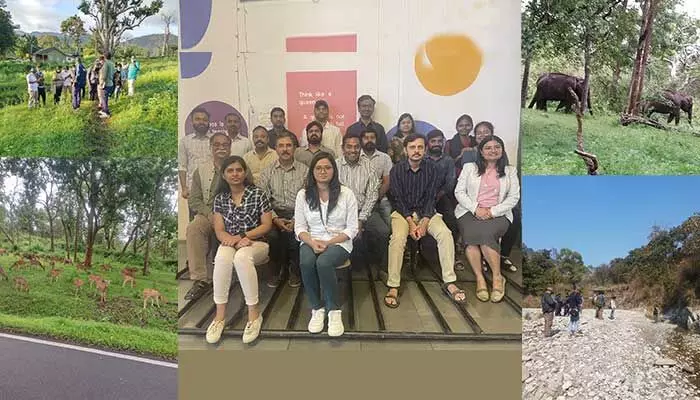Technology ‘tigers’ on the prowl: M-STriPES making mark in geospatial solutions
Kaiinos was founded to deliver location-based solutions to the price-sensitive Indian market and different geographical situations.

HYDERABAD: Meet the IIITH Alumni team that founded a start-up 'Kaiinos', to offer geo-spatial solutions in environmental conservation and also played an important role in Project Tiger.
Kaiinos, coined from the Japanese 'Kai' which means for 'innovation in open source,' was founded to deliver location-based solutions to the price-sensitive Indian market and different geographical situations.
Kaiinos was developed by Masters students at the Lab for Spatial Informatics under Prof. K S Rajan, Sudeep, Gowtham Gollapalli, Kaushik, and Mahendra, who were involved in various geospatial consultancy projects for the government.
Kaiinos is also a tribute to their mentor and professor KS Rajan, who earned his Masters and PhD from the University of Tokyo. The team, which was new to the ecological area at the time, had expertise in natural resource conservation.
"While IIITH was advising the government, some projects needed to be implemented. We identified a need for a private business to bridge the advisory-implementation gap and stepped in. Kaiinos was developed to provide location-based solutions to the price-sensitive Indian market and varied geographical scenarios, said one of the founders, Gowtham Gollapalli.
"There were so many people working on so many different things that it made sense to provide them with a platform and a space with the help of open source to access data and collaborate with each other," Gowtham added.
What began as an asset mapping operation for the Delhi government to document the amount of urban sprawl quickly evolved into a consistent focus on the environment and agriculture.
A collaborative project in the Western Ghats with IIITH and the Open Source GeoSpatial Foundation resulted in the creation of the first biodiversity Spatial Data Infrastructure(SDI)- to quantify the presence and abundance of species. The team developed small tools to assist scientists and ecologists in gathering data on key elements like biodiversity and richness index.
Scientists face difficulties accessing detailed datasets containing species information and satellite location data.
Kaiinos' landscape datasets, including vegetation density information, were utilized for correlating and planning conservation activities due to their processed data.
The founders discovered that in agriculture, data was collected on paper and filed in spreadsheets, with old sampling techniques relying on subjectivity.
"We changed all of this to location-based data capturing, which is then correlated with satellite data," explains Kaushik, one of the founders, adding that the broad data on soil, temperature, moisture, and so on collected via satellites is then personalised to fit customer requirements.
Their part in project Tiger
The media's primary focus on the 50-year completion of Project Tiger has been on the significant increase in the cat's numbers over the years. Tiger censuses were conducted through ground-based surveys to select ideal camera trap locations and understanding species richness, and from actual camera footage.
Images are collected, segregated by species, and analyzed, extracting tiger data and correlating it with other ground data, marking each tiger based on its stripes and physical characteristics.
"This was done before we got involved but the information generated was decentralised and available to individual forest departments. It was difficult to compile it for landscape-based analysis. The next thing we're doing is managing location data more structured and providing the infrastructure for conservationists to undertake much larger landscape analyses, "Gowtham explained.
M-STriPES
The Kaiinos team has developed a comprehensive platform that goes beyond mere tiger numbers, despite their modest appearance.
M-STriPES, an acronym for Monitoring System for Tigers: Intensive Protection and Ecological Status, is a platform that collects information from the field using GPS, General Packet Radio Services (GPRS), and remote sensing, creates a database using modern Information Technology (IT) based tools, and analyses the information using GIS and statistical tools to provide inferences that allow tiger reserve managers to better manage their wildlife resources’.
With the platform's three different modules - patrol, ecological, and conflict - data in the form of geotagged photos, observations made by field staff, habitat assessment, recordings of details of attacks on humans, livestock, crop damage, and more flows from the app to the National Tiger Conservation Authority (NTCA) for analysis.
The startup integrates herbivore, carnivore, and habitat data into a map, calculates richness index, and creates community, distance, and occupancy matrix for stakeholder planning. The number of tigers in a given area and distance is not only their overall number but also their number per area.
The Wildlife Institute of India and NTCA can use this data to monitor tiger movement, determine the location of new corridors, and conserve existing ones.
Habitat Assessment
Emphasising that Project Tiger is just one of the many things they focus on, the Kaiinos team speaks at length about its complete habitat health assessment solution.
“We are trying to build an entire stack from soil conservation to wildlife conservation. But before wildlife conservation there is forest conservation and before that there is water conservation and much before water is soil,” explains Kaushik.
Crediting their dedicated team of 17 that is housed at CIE, Kaushik and Gowtham aver that their challenges have never revolved around technology. It was the domain that threw us off. Though it is Math, its representation in the conservation space is completely different. Practically speaking, the Wildlife Institute of India hand held and taught us everything,” they say.
With revenue coming in from the work done for the Open Source Foundation, the Lab for Spatial Informatics, and the government, Kaiinos now has its sights set on expanding its scope in the Western Ghats region.



